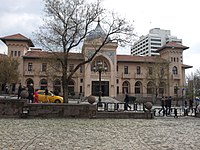First national architectural movement

The First national architectural movement (
The most important architects of the movement were Ahmet Kemaleddin and Vedat Tek, who pioneered the movement, as well as Arif Hikmet Koyunoğlu and Ottoman-born architect of Italian descent Giulio Mongeri.
History

The movement began in the early 20th-century in the capital of the Ottoman Empire, Constantinople, with the goal of bringing back "Turkish" elements in the construction and design of new buildings. Ever since the late 18th century, European architectural movements such as Baroque, Neoclassical and Rococo architecture were the styles chosen for the majority of imperial buildings built up until the early 20th century.
The first building considered to be built in the Turkish neoclassical style is the

After the Turkish War of Independence and subsequent formation of the Republic of Turkey, the new government, led by President Mustafa Kemal, further promoted the architectural style which would live out its golden years in the 1920s. Subsequent government buildings such as the second Grand National Assembly building (1924), the Ministry of Finance general headquarters (1925) and the Ministry of Culture general headquarters (1927) were all built with Turkish Neoclassical architecture.
Due to the high demand of buildings and lack of Turkish architects, Western influences once again took hold in the architecture of the 1930s. The Turkish government brought in several European architects, such as Clemens Holzmeister and Ernst Egli, to design many buildings during this period. This however did bring forth a mix of modern architecture with Turkish Neoclassical, most notably seen in the Sivas station building (1934).
The mix of architectural styles led forth to the Second national architectural movement (1939-1950).[4]
Examples
-
Old Fatih Municipality Building built by Yervant Terziyan
-
Mimar Kemaleddin Bey(1911–1926).
-
Mimar Kemaleddin Bey(1919–1922)
-
Ethnography Museum of Ankara was designed by architect Arif Hikmet Koyunoğlu (1925-1928).
Notable buildings
- Grand Post Office (1909) in Sirkeci, Istanbul.
- Land Registry General Directorate Building (1908)
- Adana station building (1912) in Kurtuluş, Adana
- Beşiktaş Pier (1913) in Beşiktaş, Istanbul.
- Karaağaç station building (1914) in Karaağaç, Edirne
- Vedat Tek House in Nişantaşı, Istanbul.
- First Grand National Assembly Building (1920) in Ulus, Ankara
- Tayyare Apartments (1922) in Laleli, Istanbul.
- Second Grand National Assembly Building (1924) in Ulus, Ankara
- Gazi station building (1926) in Ankara
- Elhamra Theater (1926) in Konak, İzmir
- Ministry of Culture General Headquarters (1927) in Sıhhiye, Ankara
- Ankara Palas (1928) in Ulus, Ankara
- Ziraat Bankası General Headquarters Building (1929) in Ulus, Ankara.
- State Art and Sculpture Museum (1930) in Altındağ, Ankara.
- Ethnography Museum of Ankara (1928) in Ulus, Ankara.
- Second Evkaf Apartments (1930) in Ulus, Ankara.
See also
References
- ^ a b "Kimlik Arayışı: I. Ulusal Mimarlık Akımı" (in Turkish). Archived from the original on 2 June 2015. Retrieved 20 October 2017.
- ^ Bozdoğan, Sibel (2003). "Modernizm ve Ulusun İnşası" (in Turkish). Retrieved 20 October 2017.
- ^ Acer, Özlem. "Birinci Ulusal Mimarlık Akımı" (in Turkish). Retrieved 20 October 2017.
- ^ Balamir, Aydan. "Mimarlık ve Kimlik Temrinleri" (in Turkish). Mimarlar Odası Genel Merkezi. Retrieved 20 October 2017.
- ISBN 978-0-8122-7925-2.

![Defter-i Hakani building in Sultanahmet, Istanbul, built by Vedat Tek[5]](http://upload.wikimedia.org/wikipedia/commons/thumb/f/f7/Istanbul_IMG_7342_1725.jpg/225px-Istanbul_IMG_7342_1725.jpg)





